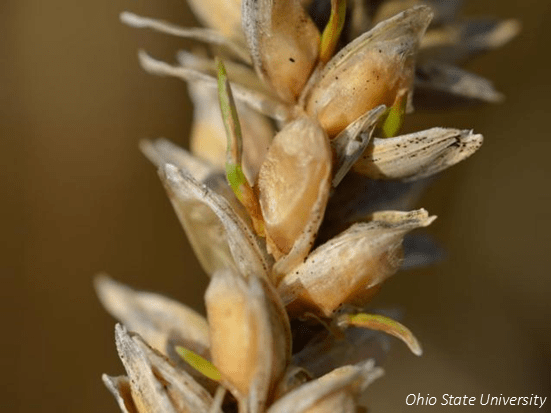Nicole Fiorellino, Extension Agronomist | nfiorell@umd.edu
University of Maryland, College Park

2023 was shaping up to be a decent wheat season, with mild winter and minimal disease impacts this spring. Although some areas of the state were dry, there were some timely rains at the end of April to get the crop through the rest of the season. We sometimes forget that wheat thrives in much drier climates than the Northeast, and what seems dry to us was probably ideal for wheat.
As wheat harvest is currently underway in some areas of the state, the hopes of high yields and disease-free grain may now be riddled with an unseen quality blemish – falling falling numbers. Growers producing wheat for use in milling or baking are paying attention to quality measures such as falling numbers, or the activity of the alpha amylase enzyme in the grain stemming from pre-harvest sprouting. As grain begins sprouting within the head, prior to harvest, alpha amylase builds up and degrades starch, which decreases flour quality. To measure falling numbers, a slurry of grain meal and water is mixed and a plunger is dropped into the slurry, with the time measured for the plunger to drop through the slurry. High alpha amylase results in low starch, which thins the slurry and the plunger falls quicker, resulting in lower falling number measures. In short, low falling numbers equals bad quality wheat that is not suitable for milling or baking.
Causes of low falling numbers, similar to disease pressure, are somewhat out of a grower’s control and not very well understood. Some areas of the state received a respite from the dry conditions, in the form of a few days with a small amount of precipitation towards the end of June. While our corn crop happily received the moisture, this was enough rain in some areas to not only delay the beginning of wheat harvest but signal the wheat grain to break dormancy and begin to sprout. Low falling numbers may also be observed in grain that did not sprout due to a defect known as late maturity alpha amylase (LMA). This is the buildup of alpha amylase in the wheat grain triggered by cold stress during maturation. It is still unclear how to specifically define “cold stress” that causes LMA but it is yet another process that increases alpha amylase in the wheat grain, decreasing flour quality. In any given season, low falling numbers can be a result of either pre-harvest sprouting or LMA or even both conditions. Susceptibility to pre-harvest sprouting and LMA are genetically linked, but even with genetic resistance, the interaction between genetics and environmental conditions can still result in decreased falling numbers.
For the 2023 wheat crop, it is important to get wheat harvested as soon as possible. There is no way to correct for falling numbers now, but growers can make every effort to get wheat out of the field as quickly as possible to avoid exposure to additional precipitation events. While all hope is not lost and wheat with low quality can still be sold for feed, any potential premiums for producing high quality wheat will be lost. For future seasons, Maryland growers can make an effort to select early maturing wheat varieties, to hopefully expedite harvest in the spring. We know the down-season benefits of early wheat harvest, such as earlier planting and higher yields of double crop soybeans, and we are also aware of the potential risk of frost damage to early maturing wheat. However, early maturing wheat varieties may be a the best option to mitigate quality issues. While your premium for 2023 may be lost, you should begin discussing your 2024 wheat crop with your crop insurance agent now, especially if you are planning to grow high quality wheat for milling or baking. There may be coverage options available to protect you from lost premiums due to poor falling numbers, for example, so now is the time to plan accordingly for 2024.
